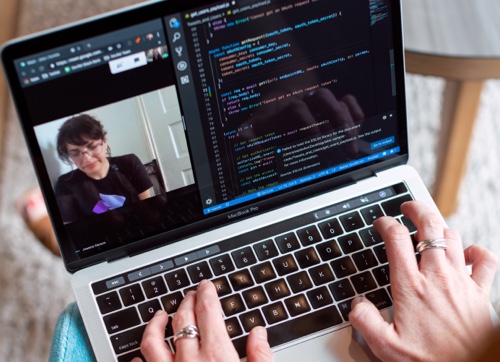About the author
Chris Griffith has been a game developer for over 19 years and a mobile developer since 2010. He’s produced dozens of apps and games for brands like Match.com, LEGO, Microsoft, Kraft, Anheuser-Busch and PepsiCo.
Chris has been a member of the PullRequest network since April 2018.
Be sure to check out other great work from Chris:
- Versioning for iOS and Android Apps - Part 1
- Versioning for iOS and Android Apps - Part 2
- The Most Common Issues I’ve Caught Reviewing Swift
- The Most Common Issues I’ve Caught Reviewing iOS Apps
- Top 3 Security Vulnerabilities I Find in iOS and Android Projects
The increase in remote work adoption began well before COVID-19. There are a number of reasons for this, from competitive, maxed-out talent pools in major tech hubs (San Francisco, New York, etc) to more progressive, trust-based work cultures throughout the industry. However, the pandemic has been a pivotal point in hiring remote developers for organizations who would have otherwise conducting interviews and meetings in-person, even if a position included the flexibility of being remote day-to-day.
For those companies which this is a new practice (and are perhaps struggling in the process), I’d love to offer some useful advice for screening adaptability of candidates and setting good matches up for success.

Consider remote work feasibility when it’s no longer a safety necessity
Is your company only embracing remote workers for 6-9 months, at which point you’ll call everyone back into the office? Or are you taking it on for the long haul, perhaps even relinquishing some expensive corporate real estate in the process? It’s essential to know the answer to this as you start talking to candidates. Someone 2-3 states away may not want to relocate 6-12 months from now when workplaces open back up. To keep from losing them when everyone else returns to the office, be upfront with them about your plans. Uncertain of what your plans are? Be upfront about that, too. If you need someone understanding and flexible, this is an excellent opportunity to find out if a candidate will be.
Get familiar with their routine
Working from home for 6+ years has taught me a lot about myself and how I work best. One of the key benefits of being unshackled from traditional 9-5 office hours is that I can pour myself into tactical work when I’m most productive and strategic work when collaborating with others. For example, I prefer to get up early before everyone else and spend several hours of uninterrupted time to focus on problems that take a great deal of concentration.
Routine varies person-to-person, but the point is to understand how a prospective candidate’s schedule works to know if it will be compatible. Ask the candidate to describe how they see their day. If your team is highly collaborative and has lots of meetings and discussions over video conferencing, you may need someone more available during “traditional” office hours. If the role is for someone who will spend 90% of their time heads-down building software and can communicate their needs over Slack, this opens you up to people who might keep unconventional hours.
Keep in mind that the pandemic has impacted other routines like school, visiting family, and social hobbies.
The critical factor is to describe the company’s needs and make sure the candidate’s needs are compatible. Encourge honesty. It’s important to lead by asking the candidate how they work best, so they don’t alter their answer to try to seem amenable. Someone may say they can “make it work,” but odds are they will struggle if they have to change all the existing elements of their schedule to do so. Keep in mind that as social distancing restrictions lift, needs will change.
Learn about the candidate’s remote work history
This one may seem obvious, but it bears mentioning. Some people have never worked outside of an office, and others may have done it for years with no issues. Never having worked from home need not be a deal-breaker for a candidate – it merely lets you know that they may need extra support when getting started. Plan to spend extra time during the onboarding process, making sure they have what they need.
An unfortunate disadvantage of remote working is that it’s more prone to breakdowns in communication. This doesn’t happen consciously; most often, it stems from people’s desire not to bother others. A person who isn’t used to remote connectivity tools, such as Slack, may need some coaching before they get comfortable with it. To get a good feel for how easily a candidate will adapt, ask questions like, “In the past, how often did you have conversations with team members over chat even when they’re in the same office building?” Also, checking in periodically is a good idea here, perhaps once a day. If your company does daily stand-ups, all the better. It will help the new employee feel connected to the team.
Assess the candidate’s comfort & familiarity with remote communication tools
This last one, of course, goes for both existing and new employees. When a company has makes the switch from in-office to remote communication, it can be difficult for some employees to transition. Walking over to someone in an office feels somehow less intrusive than calling them on Slack, learning that they are equivalent actions takes time. If someone is busy, they can decline a call, which is the remote equivalent of asking someone at their desk “Got a minute?” and them saying, “Finishing something, I’ll come by in 10.” It’s imperative to establish your remote communication protocols and expectations upfront to know if your candidate will be comfortable with them. Establish hour-specific expectations for when the candidate should be available online. This may seem micro-managerial, but it’s very reasonable, and folks tend to react well to it. If someone is busy with a critical task for a block of time, they can decline and quickly message back or use Do Not Disturb mode.
Remember that to successfully integrate a new remote developer hire into your organization; there needs to be a pre-existing, strong culture of communication on the remote collaboration tools you use. Important conversations that happen organically in an office won’t happen if you don’t take active steps to encourage it. Without addressing this, your organization’s culture will stall or deteriorate.
After you hire, use a buddy system
This is applicable after you’ve made a hire, but it’s worth mentioning here since it’s a helpful approach to screen and monitor the developer’s ability to adapt to the team in the first few weeks.
It can be hard for new employees who have never been a part of a company’s social culture to feel like a real member of the team when working remotely. All the existing folks may be close friends, having spent time together both in and out of the office. I’ve found success in providing a new remote developer (or any remote employee for that matter) two “onboarding buddies” on their first day. Ideally, these designees should be peers (not supervisors), and one should be from another department if possible. The latter is important. Having one designee from another department helps combat the new teammate being “siloed” entirely into their department, which is a common issue with distributed teams. These designees should answer all of the new teammates' questions and know who to point them to if they don’t have an answer. It can be overwhelming, particularly in larger companies, to know who to reach out to and how things work. This process eases that tension and immediately gives the new teammate two trusted contacts.
Further, if there are any strong mismatches, you and your team will be able to catch and correct early. You’ll have at least two individuals' thoughts on how well the new teammate is adapting and multiple perspectives of strengths they bring to the organization.
Wrapping it up
Some have predicted that many companies forced to work remotely will continue to do so once the pandemic subsides, and experts have projected this won’t take place until 2021. In terms of remote development team compositions, I believe there are positive side effects of this. I think it will free many people to live where they might prefer (whether for financial, familial, or other considerations) and will open and redistribute talent pools, especially in the tech sector. Regardless of what companies do in the long term, it’s essential to know how to deal with the present situation. Remote developers can be just as productive (and in some cases, more) as those in-office if companies are set up to get the most out of them and make sure they know that they’re important contributors to a team and building meaningful things.
Be sure to check out other great work from Chris:
